This fun little experiment will help children begin to understand the concept of density. Density is the amount of parts squished together to make up a liquid. The more tightly packed the parts are, the more dense the liquid. (This is difficult concept to explain, so experiments like this will provide a visual aid!)
What You’ll Need: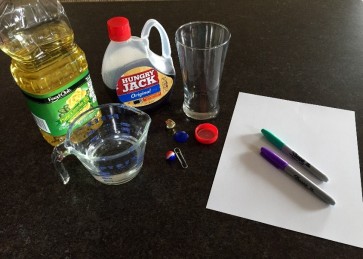
- unbreakable clear glass or jar
- water
- vegetable/canola oil
- pancake syrup or dark corn syrup
- small items (marble, bell, plastic lid, button, paper clip)
- paper
- markers
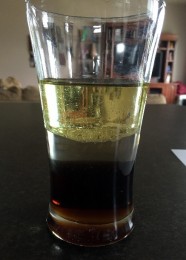 Step 1: First, pour some pancake syrup into an unbreakable clear glass or jar. Then slowly add some water on top of the syrup. Have children observe the water and the syrup. Did the water mix with the syrup or stay on top of it? Syrup is more dense, so it stayed at the bottom. Carefully add some vegetable/canola oil, and have the children observe the glass again. The three liquids stay separated because they are all different densities. (If they seem to mix, wait and you should see them separate after a few moments.)
Step 1: First, pour some pancake syrup into an unbreakable clear glass or jar. Then slowly add some water on top of the syrup. Have children observe the water and the syrup. Did the water mix with the syrup or stay on top of it? Syrup is more dense, so it stayed at the bottom. Carefully add some vegetable/canola oil, and have the children observe the glass again. The three liquids stay separated because they are all different densities. (If they seem to mix, wait and you should see them separate after a few moments.)
Step 2: Place some small items on the tabletop next to the glass. (I chose a marble, plastic lid, metal paper clip, button, and a bell for my experiment.) Make a simple chart and challenge the children to predict where each of the items will settle in the glass.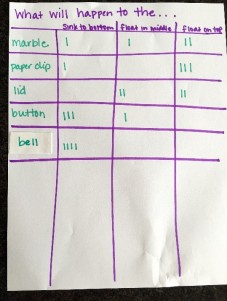 (Note: Charts don’t have to be fancy or created on a computer. Children can benefit by watching you draw a simple chart on paper with marker.)
(Note: Charts don’t have to be fancy or created on a computer. Children can benefit by watching you draw a simple chart on paper with marker.)
Explain that the chart will be used to help you remember the children’s predictions.
Step 3: Create another chart to record actual results. Invite the children to take turns dropping the items into the glass. What happens? Where did each item land? Did it sink to the bottom, float on the top, or land somewhere in the middle? Record the results on the second chart, and compare the results with the children’s predictions. Remind children that when experimenting, predictions may be incorrect. That is how scientists study and learn!
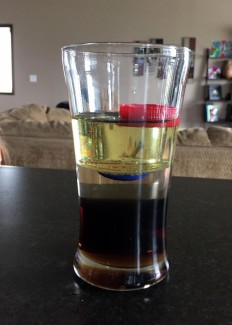
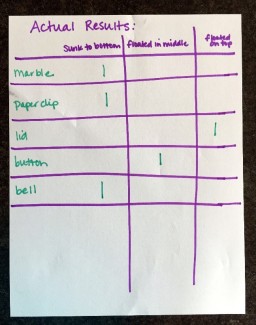
Extension: Experiment further with density by a offering other small materials, predicting where they will land in the glass, and testing to find out.
Note for Providers: So WHY did the items sink or float in different sections?
Objects and liquids float on liquids of a higher density and sink through liquids of lower density. The button sunk through the oil but floated on the water, while the bell and paper clip sunk through both the oil and water. That means the bell and paper clip are more dense than the oil and water. The plastic lid was less dense than all three liquids, and therefore floated on top.
Back to blog listing